Chapter 20
Case Study: The Eurotunnel Project
The first recorded plans for a cross-English Channel link between the United Kingdom and France date back to 1753.1 Since the early nineteenth century other plans for linking Britain with the mainland have periodically been drafted and then shelved. Tunneling actually started on the British side in 1882. But it was abandoned soon after. The mouth of the unfinished tunnel still yawns from the chalk bedrock near Dover.
The Eurotunnel Project was initiated in 1984. The construction was planned as a twin-bore rail tunnel with associated infrastructure, rolling stock, and terminals. Upon completion, scheduled for 1993, it would join the rail systems of the United Kingdom, France, and the rest of mainland Europe. Its comfortable, fast, frequent, and reliable service would furnish a valuable link between the United Kingdom and France, beneath the English Channel. The construction was technically straightforward from an engineering standpoint. However, the enormity of the undertaking would require close logistical coordination.
The project had symbolic value. It was initiated at about the time members of the European Economic Community (EEC) were ratifying the Single European Act to create, by 1992, a single integrated European economic system. The project was also innovative. The method of financing, which provided for private capital to bear the long-term infrastructure development risk, had not been tested in the world capital markets for decades.
Historical Background
In 1973, French President Georges Pompidou and British Prime Minister Edward Heath signed a treaty to construct a twin-bore rail tunnel under the English Channel. Tunneling began in 1974. But when Heath's Conservative government was defeated, the treaty lapsed without ratification by the British Parliament, and tunneling was again abandoned.
In the early 1980s, investigations probed the possibility of constructing a fixed link across the English Channel (i.e., a bridge or tunnel), financed purely by private capital. Studies commissioned by the British and French governments culminated in the publication of a report by the Anglo-French Study Group in 1982. The report recommended construction of a rail link. However, it was widely believed at the time that the report would never be implemented.
In May 1984, Banque Indosuez, Banque Nationale de Paris, Crédit Lyonnais, Midland Bank, and National Westminster Bank (together, the “Arranging Banks”) presented to the governments of the United Kingdom and France a report detailing how a fixed link across the Channel, consisting of a twin-bore rail tunnel, might be project financed entirely with private capital. The Arranging Banks subsequently teamed up with some of the largest construction companies in the United Kingdom and France to form The Channel Tunnel Group Limited in the United Kingdom and France Manche S.A. in France (CTG and FM, respectively). CTG-FM was organized as a general partnership to develop what would become the Eurotunnel System. With its prior experience, CTG-FM was the consortium most advanced in its plans when the British and French governments issued a joint “Invitation to Promoters” in April 1985. Interested parties were invited to submit bids, before the end of October 1985, for the financing, construction, and operation of a fixed link across the Channel without recourse to government funds or guarantees.
Ten proposals were submitted in October 1985. Four principal contenders were identified:
In January 1986, the Eurotunnel System was selected as the winning project. In February 1986, the British and French governments signed a treaty by which they authorized construction of the Eurotunnel System and agreed to grant the concession to operate the Eurotunnel System (the “Concession”) to the winning bidders, CTG in the United Kingdom and FM in France. CTG-FM then provided £50 million in seed capital (referred to as “Equity Offering I”).
The Concession gave CTG-FM the right to build and operate the Eurotunnel System for a period of 55 years from the date the treaty was ratified. CTG-FM would have the discretion to establish tariffs and to determine its own operating policies for the Eurotunnel System. The British and French governments committed that no competing fixed link could be built before the end of 2020 without CTG-FM's approval. At the end of the Concession, in 2042, ownership of the Eurotunnel System would revert to the British and French governments. This structure fits the build-operate-transfer (BOT) model for public-private transportation infrastructure partnerships discussed in Chapter 16.
The Eurotunnel Project encountered early opposition. A group of ferry owners, port interests, and environmentalists established Flexilink to oppose construction of a fixed link between England and France. Flexilink predicted a severe price war between the fixed link and ferry operators if the fixed link were built. Flexilink subsequently accused CTG-FM of misestimating the capital cost of the Eurotunnel System, tariffs, and traffic. It argued that the growth in cross-Channel traffic would slow down and that the tunnel would prove to be unprofitable and end up as a drain on British taxpayers.
The Eurotunnel System
The Eurotunnel System would comprise:
 Twin rail tunnels and a service tunnel under the English Channel.
Twin rail tunnels and a service tunnel under the English Channel. Two terminals, one at Folkestone near Dover in the United Kingdom and the other at Coquelles near Calais in France.
Two terminals, one at Folkestone near Dover in the United Kingdom and the other at Coquelles near Calais in France. Specially built shuttles to carry passenger and freight vehicles between the terminals.
Specially built shuttles to carry passenger and freight vehicles between the terminals. Inland clearance depots for freight at the French terminal and at Ashford (near Folkestone) in the United Kingdom.
Inland clearance depots for freight at the French terminal and at Ashford (near Folkestone) in the United Kingdom. Connections to nearby roads and rail facilities.
Connections to nearby roads and rail facilities.Each of the two main tunnels would have an internal diameter of 7.6 meters and a total length of approximately 50 km. In addition, there would be a service tunnel of 4.8 meters internal diameter. Cross-passages would link it to the main tunnels. The service tunnel would provide ventilation to the main tunnels. It would also facilitate routine safety and maintenance work and provide a safe refuge in case of emergency. Two crossovers were planned between the rail tunnels. These would allow trains to continue to operate during periods of tunnel maintenance, albeit at a reduced frequency on a single track.
Project Ownership Structure
The ownership structure for the Eurotunnel Project, illustrated in Figure 20.1, could be described as a dual-bodied transnational hybrid. It involves parallel groups of companies with common shareholders. The two groups are separately registered; Eurotunnel PLC is located in the United Kingdom and Eurotunnel S.A. is located in France. They are joined together in a general partnership (hereafter referred to as “Eurotunnel”).
Figure 20.1 Ownership Structure for the Eurotunnel Project
Source: R. C. Smith and I. Walter, “Eurotunnel—Background,” p. 4.

CTG and FM had previously entered into an association constituting a partnership under English law and a société en participation under French law, for the purpose of constructing and operating the Eurotunnel System. Profits and losses (after financing and other costs but before depreciation and taxes) would be divided equally between CTG and FM.
Eurotunnel Finance Limited and Eurotunnel Finance S.A. would manage Eurotunnel's finances. Eurotunnel Developments Limited would enter into joint venture arrangements with third parties to develop property in the United Kingdom not required for the Eurotunnel System, business opportunities brought about as a result of the Eurotunnel System, and Eurotunnel System traffic.
Construction
Construction was to be carried out by a consortium of construction firms known as Transmanche Link. The consortium entered into a single general-obligation contract to design, construct, test, and commission a fully operational rail system within seven years of signing the construction contract. The construction contract was signed in August 1986. Transmanche Link was a joint venture of Translink of the United Kingdom, which consisted of five leading British construction firms, and Transmanche Construction of France, which consisted of five leading French construction firms.
The construction contract was divided into three principal parts:
Transmanche Link would be held liable for damages of about £350,000 per day for delays up to six months, and £500,000 per day thereafter if the Eurotunnel Project was delayed beyond the final completion deadline. The obligations of Transmanche Link would be secured by a performance bond equal to 10 percent of the total value of the contract, which would be released upon completion of the Eurotunnel Project. In addition, 5 percent of the amount due to Transmanche Link as progress payments would be withheld or covered by a performance bond during the construction period. The payments or the bond would be released in two installments, 12 months and 24 months following completion of the Eurotunnel Project. The five French and five British parent companies of Transmanche Link would also give general guarantees covering 100 percent of the contractual obligations of Transmanche Link. The joint liability of each of the French parents and the several liability of each of the British parents was limited to 50 percent and 10 percent, respectively.
Transmanche Link would not be entitled to any release from obligations due to strikes by its own labor force; however, general strikes interrupting the required flow of goods or materials would be an event of force majeure and would lead to extension of the completion deadline. Similarly, Transmanche Link would be liable for delays and cost overruns caused by accidents or flooding. However, it would not be liable for delays or cost overruns caused by (1) changes in specifications made by Eurotunnel, (2) actions taken by the British or French governments, or (3) bedrock conditions that turned out to be different from those Eurotunnel had determined to be reasonably expected.
It was widely believed that construction of the Eurotunnel System would not be a difficult technical exercise. Conditions for construction of the Eurotunnel System were excellent. Moreover, the simplicity of the design—which had been a key factor in its selection by the British and French governments—increased the chances that the Eurotunnel Project would be completed on time and within budget.
The risk of interruption of service following completion was deemed to be low. Eurotunnel and Transmanche Link believed that once the three tunnels were completed, only a major earthquake could cause the tunnel to flood and collapse.
Project Financing
Eurotunnel estimated that it would cost approximately £4.8 billion to build the Eurotunnel System:
| Construction costs | £2.8 billion |
| Corporate and other costs | 0.5 |
| Provision for inflation | 0.5 |
| Net financing costs | 1.0 |
| Total | £4.8 billion |
Table 20.1 provides a detailed cost breakdown. To meet these costs and cover possible cost overruns, Eurotunnel planned to raise £6.0:
| Equity | £1.0 billion |
| Loans | 5.0 |
| Total | £6.0 billion |
Table 20.1 Expected Cost of the Eurotunnel Project (Millions of Pounds Sterling).
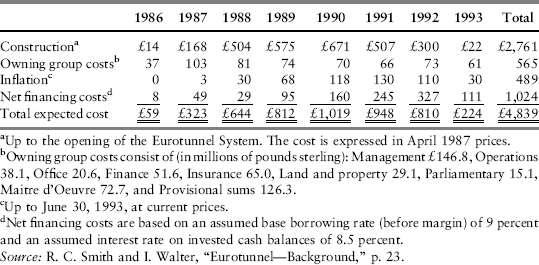
To cope with the tricky problem of raising this amount of funds for a greenfield venture without third-party guarantees, Eurotunnel planned to raise the funds in stages:
It was anticipated that during the Eurotunnel System's first full year of operation, 79 percent of its total costs would consist of capital charges (i.e., interest and depreciation). Capital charges as a proportion of total costs would decline steadily thereafter. Eurotunnel expected that, after completion risk had been eliminated, it would be able to refinance much of the project debt with cheaper financing, which would further reduce the debt service burden.
Economic Risk
The two national-government-owned railway companies, British Rail (BR) and Société Nationale des Chemins de Fer Francais (SNCF), would be the two largest direct customers of the Eurotunnel System. Their relationship with the Eurotunnel System would be defined by contract. Eurotunnel expected that half of the Eurotunnel System's revenues would come from these two railways; the other half would come from road vehicles. The vehicles, together with their drivers and passengers, would be transported in specially designed shuttles running at speeds of up to 160 kph between the terminals.
Eurotunnel expected to have a competitive advantage over existing cross-Channel transportation—via ferry, hovercraft, and airline services. Eurotunnel's services would be less vulnerable to the adverse weather conditions in the Channel that can seriously disrupt ferry and hovercraft crossings. Eurotunnel could operate all year, and it planned to offer a higher frequency of service than the existing ferry and hovercraft operators. Figure 20.2 compares the shuttle's cross-Channel travel time to those of the ferry and hovercraft services, outside the periods of exceptional demand and under good weather conditions.
Figure 20.2 Comparison of Cross-Channel Travel Times for Three Modes of Travel
Source: Eurotunnel P.L.C./Eurotunnel S.A., Offer for Sale of 220,000,000 Units with New Warrants (November 16, 1987), p. 28; and R. C. Smith and I. Walter, “Eurotunnel—Background,” p. 11.
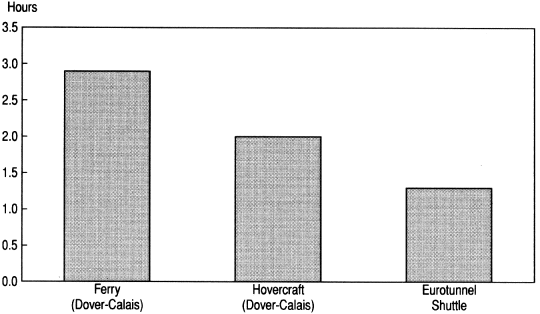
In France, SNCF proposed to build a new high-speed rail line between Paris and Brussels and to construct a branch that would link the new rail line to the French terminal of the Eurotunnel System. The proposed lines would enable the new passenger trains to travel at speeds of up to 300 kph in France and Belgium. With planned improvements to traditional tracks in the United Kingdom, direct rail service between London and Paris would take approximately 3 hours, and direct service between London and Brussels would take approximately 2 hours and 30 minutes. Figure 20.3 compares the expected travel times between London and Paris before and after the introduction of high-speed train service. The Eurotunnel System and the high-speed train would be competitive with the air travel time.
Figure 20.3 Comparison of Travel Times between London and Paris for Various Modes of Travel
Source: Eurotunnel P.L.C./Eurotunnel S.A., Offer for Sale of 220,000,000 Units with New Warrants (November 16, 1987), p. 29; and R. C. Smith and I. Walter, “Eurotunnel—Background,” p. 12.
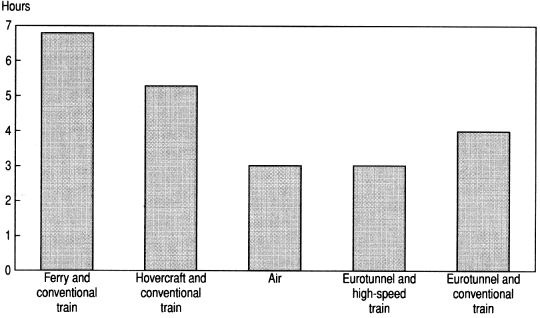
To assess the likely future demand for the Eurotunnel System and the resultant revenue prospects for the concession period, Eurotunnel commissioned various marketing studies. The marketing consultants (1) reviewed past trends in passenger and freight traffic by sea and passenger traffic by air between the United Kingdom and mainland Europe; (2) assessed the likely total traffic flows in 1993 and thereafter; (3) estimated the Eurotunnel System's share of this future market (“diverted traffic”); (4) prepared a forecast of the incremental traffic to which the Eurotunnel System was likely to give rise (“created traffic”); and (5) estimated the revenues the Eurotunnel System could expect to realize from providing transportation services and related ancillary services.
Table 20.2 summarizes the consultants' assessments. These assessments were based on the assumptions that (1) high-speed rail service would be available between London and both Paris and Brussels at the start of the Eurotunnel System's operations and (2) Eurotunnel would be permitted to operate its facilities duty-free throughout the concession period.
Table 20.2 Projected Demand for the Eurotunnel System.
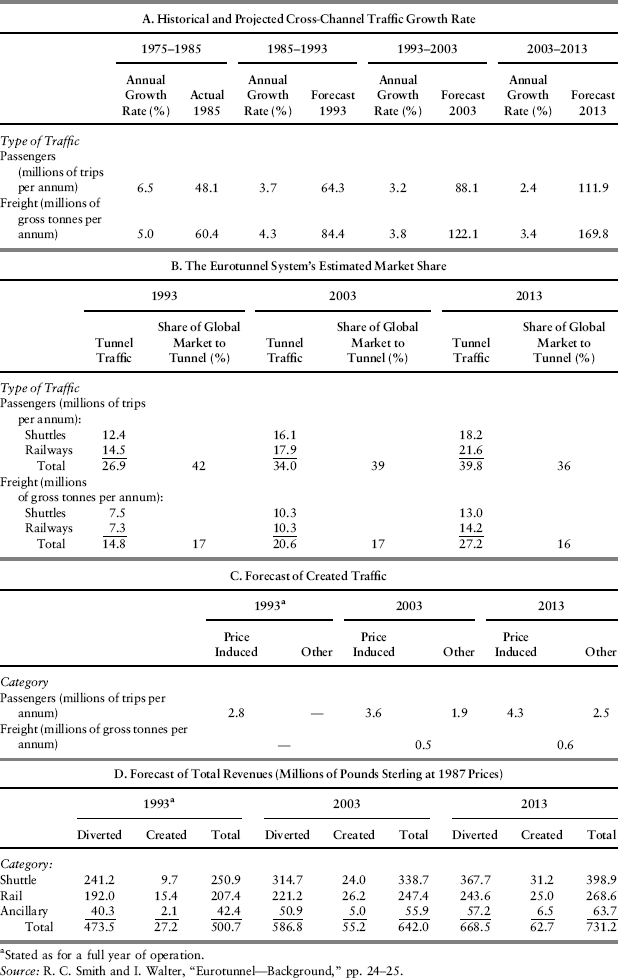
The marketing studies concluded that the Eurotunnel System was economically feasible. They projected that the total cross-Channel traffic market would grow from 48.1 million passenger trips and 60.4 million tonnes of freight in 1985 to 88.1 million passenger trips and 122.1 million tonnes of freight by 2003. They concluded that the Eurotunnel System would be able to capture a large proportion of this growing market. The Eurotunnel System would not require prebooking, and it would be substantially faster and more convenient and reliable than existing ferry services. It would also be competitive with air services in terms of both cost and time. The studies projected that the Eurotunnel System would capture roughly 42 percent of the cross-Channel passenger market in 1993. Concerning rail freight, the Eurotunnel System would provide a through service for the first time. Because the service would avoid transshipment, rail freight would become competitive with road freight to and from the United Kingdom. In 1993, roughly 17 percent of cross-Channel freight traffic would go through the Eurotunnel System, according to the studies. The passenger and freight market shares were projected to decline to 36 percent of passenger traffic and 16 percent of freight traffic by 2013.
The marketing studies also concluded that the Eurotunnel System's existence would lower the cost of travel and thereby generate a certain amount of new traffic. According to the marketing forecasts, the Eurotunnel System would carry a total of 30 million passengers and 15 million tonnes of freight in its first full year of operations.
Revenue would come from three sources: (1) shuttle fares (assumed at opening to match the then-prevailing fares for Dover–Calais ferries), (2) railway charges and tolls, and (3) ancillary revenues, consisting principally of catering and duty-free sales to passengers, and charges levied on the use of the tunnel as a conduit for cables.
As Table 20.2 indicates, the marketing studies projected that total revenue in 1993, stated for a full year of operations, would approximate £500 million in April 1987 prices and would rise to £642 million in 2003. The revenue breakdown was expected to be: shuttle revenue 50 percent, rail revenue 41 percent, and ancillary revenue 9 percent.
The base case projections were predicated on a United Kingdom GDP growth rate of 2.15 percent per annum (p.a.) from 1985 to 2003, and 2.0 percent p.a. thereafter; a French GDP growth rate of 2.25 percent p.a.; and a Belgian GDP growth rate of 1.9 percent p.a. Table 20.3 illustrates the effect on revenues of variation in growth rates of 0.5 percent p.a. and the effect of varying ferry tariffs and tunnel tolls by 10 percent.
Table 20.3 Sensitivity of Projected Eurotunnel Revenues to Changes in GDP Growth Rate, Ferry Tariffs, and Tunnel Tolls.
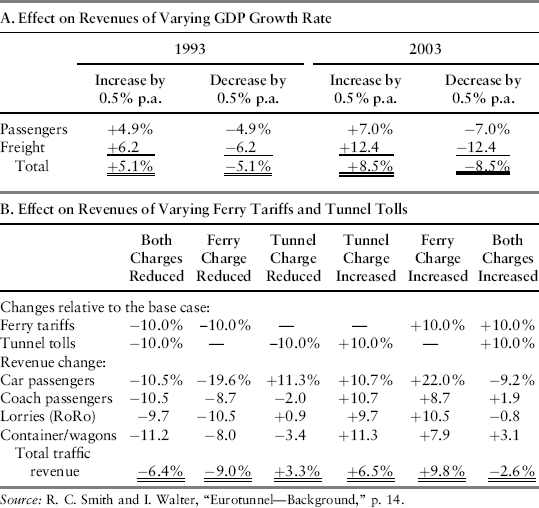
After reviewing the marketing studies, Prognos AG of Switzerland concurred with the marketing studies' conclusion that the ferry operators had a very limited ability to reduce their tariffs in response to the opening of the Eurotunnel System. Prognos stated that a price war would be to the disadvantage of the ferry operators in the long term.
Eurotunnel signed agreements with BR and SNCF guaranteeing, for the first 12 years of the Eurotunnel System's operation, the payment of 60 percent of forecast tolls. These agreements would be critical to the success of the Eurotunnel Project.
Projected Financial Results
Table 20.4 shows the projected income for the Eurotunnel Project. It was assumed that the Eurotunnel System would open in May 1993, at which time it would be fully operational for all forms of shuttle and train traffic. The projections also made these key assumptions:
 United Kingdom gross domestic product would grow at 2.15 percent p.a. between 1985 and 2003 and at 2.00 percent p.a. between 2003 and 2013. The growth rate in traffic was assumed to decrease each year after 2013, reaching zero in 2042.
United Kingdom gross domestic product would grow at 2.15 percent p.a. between 1985 and 2003 and at 2.00 percent p.a. between 2003 and 2013. The growth rate in traffic was assumed to decrease each year after 2013, reaching zero in 2042. No alternative fixed link across the English Channel would become operational before the concession period ends in 2042.
No alternative fixed link across the English Channel would become operational before the concession period ends in 2042. The tariffs the Eurotunnel System charges would, on average, equal the ferry tariffs on the Dover–Calais route and would remain constant in real terms.
The tariffs the Eurotunnel System charges would, on average, equal the ferry tariffs on the Dover–Calais route and would remain constant in real terms. Rail usage charges would conform to the specifications of the railway usage contract, and the high-speed railway linking Brussels, Paris, and the Eurotunnel System terminal in France would be operational by the time the Eurotunnel System opened.
Rail usage charges would conform to the specifications of the railway usage contract, and the high-speed railway linking Brussels, Paris, and the Eurotunnel System terminal in France would be operational by the time the Eurotunnel System opened. Eurotunnel would be permitted to make duty-free and tax-free sales to shuttle passengers (the principal source of the ancillary revenues reported in Table 20.4).
Eurotunnel would be permitted to make duty-free and tax-free sales to shuttle passengers (the principal source of the ancillary revenues reported in Table 20.4). Traffic and revenues would conform to the traffic and revenue projections prepared by Eurotunnel's traffic and revenue consultants.
Traffic and revenues would conform to the traffic and revenue projections prepared by Eurotunnel's traffic and revenue consultants. Subject to restrictions contained in Eurotunnel's loan agreement, all profits available for distribution each year would be distributed as dividends to shareholders.
Subject to restrictions contained in Eurotunnel's loan agreement, all profits available for distribution each year would be distributed as dividends to shareholders. The sterling–franc exchange rate would remain constant at £1:FF10 throughout the entire concession period.
The sterling–franc exchange rate would remain constant at £1:FF10 throughout the entire concession period. The rates of inflation in revenues, overhead, operating costs, and capital expenditures would be identical each year. The specific annual inflation rates assumed in preparing the projections were: 4.0 percent in 1987; 4.5 percent in 1988; 5.0 percent in 1989; 5.5 percent in 1990; and 6.0 percent in 1991 and thereafter.
The rates of inflation in revenues, overhead, operating costs, and capital expenditures would be identical each year. The specific annual inflation rates assumed in preparing the projections were: 4.0 percent in 1987; 4.5 percent in 1988; 5.0 percent in 1989; 5.5 percent in 1990; and 6.0 percent in 1991 and thereafter. The interest rate on cash balances would be a constant 8.5 percent p.a. throughout the concession period.
The interest rate on cash balances would be a constant 8.5 percent p.a. throughout the concession period. CTG and FM would share all revenues and costs (other than depreciation and taxes) equally throughout the concession period.
CTG and FM would share all revenues and costs (other than depreciation and taxes) equally throughout the concession period. The travel privileges granted subscribers to Equity Offering III (discussed below) would not materially affect the Eurotunnel System's revenues, operating costs, or tax liabilities.
The travel privileges granted subscribers to Equity Offering III (discussed below) would not materially affect the Eurotunnel System's revenues, operating costs, or tax liabilities.Table 20.4 Profit Projections for the Eurotunnel Project (Millions of Pounds Sterling).
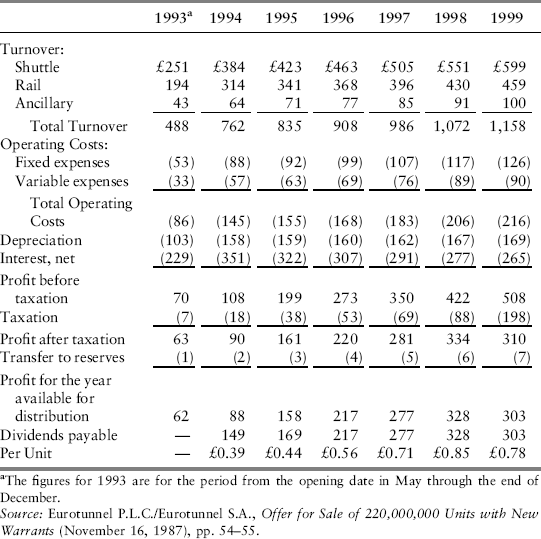

Project Debt Financing
In February 1986, National Westminster Bank, Midland Bank, Banque Indosuez, Banque Nationale de Paris, and Crédit Lyonnais were attempting to syndicate the £5.0 billion project loan (the “Project Loan Facility”) for the Eurotunnel Project among approximately 40 second-tier underwriting banks. These banks were asked to give pre-underwriting commitments that would be conditional on several key events, specified below. Owing to the size and complexity of the Eurotunnel Project and the length of time anticipated between commitment and syndication, the Arranging Banks asked the underwriting banks to furnish letters of commitment. They expected to convert these commitments into a full underwriting agreement, which would underpin the loan syndication. In February 1986, however, the borrower had not yet been formed, the construction contract had not yet been drafted, and the governments of the United Kingdom and France had not yet granted the Concession to CTG and FM. Therefore, it would have been premature to sign a formal underwriting agreement.
The Arranging Banks had good reason to approach the market in this slightly unorthodox manner. They felt it was essential for them to augment their underwriting commitments—rumored to be approximately £4.3 billion—in order to secure commitments for the full £5.0 billion budgeted for total credit facilities. They believed that arranging these additional commitments would preserve political momentum and demonstrate to the equity market that the Eurotunnel Project's entire debt financing was “locked up.” Only then could Eurotunnel hope to tap the equity market successfully.
Conditions Precedent to Signing the Underwriting Agreement
The following events would have to occur before the underwriting banks would formally enter into the underwriting agreement:
Terms and Conditions of the Project Loan Facility
The Arranging Banks proposed the following terms and conditions for the Project Loan Facility.
| Amount | Sterling Equivalent |
| £2,600 million | £2,600 million |
| FF21,000 million | £2,100 million |
| US$450 million | £300 million |
 A third equity offering (Equity Offering III) would have to be completed to increase total paid-in equity capital to £1.0 billion.
A third equity offering (Equity Offering III) would have to be completed to increase total paid-in equity capital to £1.0 billion. Capital expenditures representing at least £700 million would have to be funded out of equity capital.
Capital expenditures representing at least £700 million would have to be funded out of equity capital. Satisfactory construction progress (as specified in the Credit Agreement) would have to be made.
Satisfactory construction progress (as specified in the Credit Agreement) would have to be made. The banks would have to continue to be reasonably satisfied with the validity of the capital cost estimate.
The banks would have to continue to be reasonably satisfied with the validity of the capital cost estimate. To the Arranging Banks:
To the Arranging Banks:  percent of the total amount of funds raised.
percent of the total amount of funds raised. To the Underwriting Banks:
To the Underwriting Banks:  percent of the underwritten amount, payable to each bank pro rata to its underwriting commitment.
percent of the underwritten amount, payable to each bank pro rata to its underwriting commitment. Pre-Loan Commitment Fee: ¼ percent p.a. on committed amounts, payable from March 14, 1986, until the signing of the Credit Agreement.
Pre-Loan Commitment Fee: ¼ percent p.a. on committed amounts, payable from March 14, 1986, until the signing of the Credit Agreement. Regular Commitment Fee:
Regular Commitment Fee:  percent p.a. on the undrawn amount. Amounts covered by the additional commitment fee would be excluded. The regular commitment fee would be payable from the date of signing the Credit Agreement until the end of the availability period.
percent p.a. on the undrawn amount. Amounts covered by the additional commitment fee would be excluded. The regular commitment fee would be payable from the date of signing the Credit Agreement until the end of the availability period. Additional Commitment Fee: ¼ percent p.a. on the undrawn amount budgeted to be used in the current half year; percent p.a. on any amounts drawn over the budgeted amount.
Additional Commitment Fee: ¼ percent p.a. on the undrawn amount budgeted to be used in the current half year; percent p.a. on any amounts drawn over the budgeted amount. percent p.a.
percent p.a.Table 20.5 Base Case Sources and Uses of Funds (Millions of Pounds Sterling).
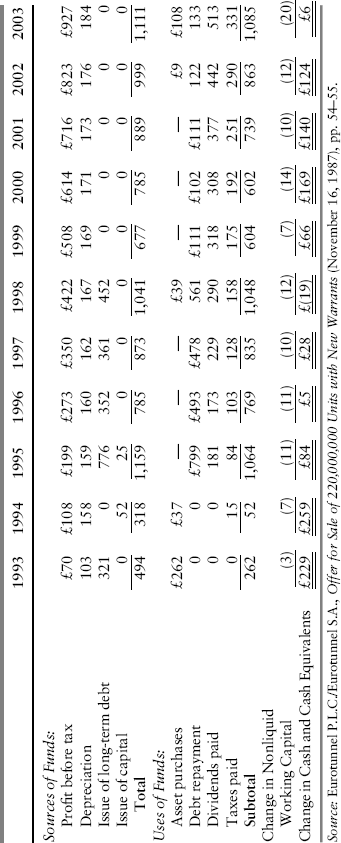
The treaty between the United Kingdom and France was ratified, and the Concession came into force in July 1987. Later that month, the underwriting of the £5.0 billion Project Loan Facility was finalized. The Project Loan Facility was syndicated in September 1987 among 130 banks worldwide.
Project Equity Financing
The prospectus for Equity Offering III, dated November 16, 1987, outlined the terms under which the international syndicate of underwriters were offering 45.9 percent of the equity of Eurotunnel PLC (EPLC) and Eurotunnel S.A. (ESA) to investors through the issuance of 220 million paired shares with warrants attached (Units). Equity Offering III was intended to raise £770 million of equity to bring the total equity raised for the Eurotunnel Project to £1.023 billion.
Equity Offering II, a private placement consisting of £200 million worth of Eurotunnel paired shares, was launched in October 1986. It had been undersubscribed in the United Kingdom, and demand in the United States had been disappointing. Political and organizational uncertainties, which had led to doubts about whether the Eurotunnel Project would ever be built, were largely responsible. The British subunderwriters had avoided significant losses due to (1) oversubscription in France, Japan, and Germany and (2) the Bank of England's pressuring investment houses in the City of London to subscribe.
Eurotunnel in November 1987
By November 1987, all the significant political and legal impediments to constructing the Eurotunnel System had been removed. The syndication of the £5.0 billion Project Loan Facility was completed in September 1987. But the stock market crash of October 1987 had introduced a new element of uncertainty.
Equity Offering III
Equity Offering III consisted of an initial public offering of the Units. Each Unit included a single share of EPLC (the U.K. company), a single share of ESA (the French company), and one detachable warrant. A holder could exchange 10 warrants plus 230 pence plus 23 French francs at any time between November 15, 1990, and November 15, 1992, to obtain one additional share each in EPLC and ESA. The Units would trade in the public equity markets in London and Paris. Under the articles of association of both companies, the shares of EPLC and ESA were paired and could not be separated.
The Underwriting
Equity Offering III was a fully underwritten offering divided into three tranches: (1) a French tranche, (2) a British tranche, and (3) an international tranche. In December 1986, Eurotunnel awarded jointly to Banque Indosuez and Robert Fleming & Co. the mandate to be lead managers and underwriters of Equity Offering III. The lead managers subsequently expanded the underwriting syndicate to include other leading issuing houses from France and the United Kingdom. In April 1987, the underwriters decided to postpone Equity Offering III until October 1987. In the interim, Eurotunnel signed a £73.5 million equivalent bridge loan (denominated in pounds sterling and French francs), which would be repaid out of the proceeds from Equity Offering III. In November 1987, the underwriters decided that the French tranche should consist of 101 million Units, underwritten at a price of FF35 per Unit; the British tranche should comprise 101 million Units, underwritten at a price of 350p per Unit; and the international tranche should amount to 18 million Units at a price of 175p plus FF17.50 per Unit.
Equity Placements
Both the British tranche and the French tranche were to be placed in accordance with standard equity issuance practices in those countries. In the United Kingdom, the underwriters had preplaced 42 million Units with certain institutional investors, leaving only 59 million Units to be subunderwritten and allocated to bidders. In France, Units would be distributed largely through the banking system on a first-come, first-served basis.
Projected Returns to Equity Investors
Equity investors in Eurotunnel would look primarily to the stream of dividends their shares would provide for the return of and a return on their Eurotunnel equity investments. The life of the Eurotunnel System, from the investors' perspective, would have three distinct phases:2 (1) the construction period (1987–1992), when equity funds would be invested; (2) the start-up period (1993–1995), when final testing would be conducted, operations would commence, and dividend payments would commence; and (3) the main operating period (from 1995 to the end of the concession period in 2042), when dividends would be paid. Beginning with this latter period, dividends were projected to grow as project debt was amortized and as revenues increased with inflation. Table 20.6 reproduces the dividend projections in the prospectus for Equity Offering III.
Table 20.6 Projected Dividends to Eurotunnel Shareholdersa (Millions of Pounds Sterling Except for Per-Share Amounts).
a. Assumes the rate of inflation is 4 percent p.a. in 1987, rises to 6 percent p.a. by 1991, and remains at 6 percent p.a. thereafter.
Source: Eurotunnel P.L.C./Eurotunnel S.A., Offer for Sale of 220,000,000 Units with New Warrants (November 16, 1987), pp. 54–55.
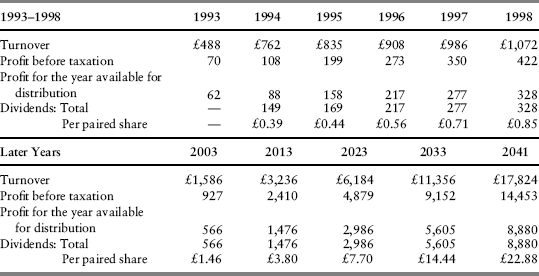
In addition to dividends, Eurotunnel offered travel privileges to individual subscribers3 to Equity Offering III, on the following basis:
| Number of Units Purchased | Travel Privileges |
| 100 | One round trip to be taken within one year of the opening of the Eurotunnel System. |
| 500 | One round trip per year during the first 10 years of operation of the Eurotunnel System. |
| 1,000 | Two round trips per year until the end of the concession period. |
| 1,500 | An unlimited number of shuttle trips until the end of the concession period. |
Market Response to the Offering
In Paris, confidence in Equity Offering III was strong. The mood in London, however, was cautious. Managers of performance-related funds, such as unit trusts and investment trusts, were not enthusiastic because of the seven-year gap between the investment and the initial receipt of dividends. Pension funds were concerned about whether the degree of risk made the investment inappropriate (or worse, illegal) for them.4 Nevertheless, Equity Offering III was successfully completed.
Sensitivity Analysis
Eurotunnel prepared a number of sensitivity analyses in addition to its “best guess” cash flow projections (the “Base Case”). The sensitivity analyses tested the effects on project performance of changes in key variables:
| Case | Change in Variable |
| 1 | Increasing construction costs and related expenses by 10 percent. |
| 2 | Delaying tunnel opening by six months and encountering construction and operating cost overruns of £270 million. |
| 3 | Reducing revenues by 15 percent each year throughout the concession period. |
| 4 | Assuming high-speed Brussels-Paris Eurotunnel railway service is never available. |
| 5 | Increasing real interest rates by 2 percent p.a. (i.e., from 8.5 percent to 10.5 percent p.a.). |
| 6 | Increasing the rate of inflation, in 1 percent increments, from 5 percent in 1987 to 9 percent in 1991; decreasing it, in 1 percent decrements, to 6 percent in 1994; and keeping it constant at 6 percent p.a. thereafter. |
| 7 | Combining cases 2, 3, and 5 into a severe downside case. |
Table 20.7 summarizes the results of these sensitivity analyses and compares them with the Base Case.
Table 20.7 Sensitivity Analysis.
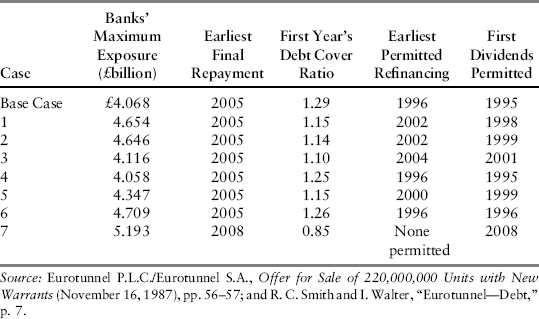
Subsequent Developments
The Eurotunnel System was originally scheduled to open in May 1993. After a number of delays, due principally to construction cost, equipment delivery, and testing problems, the tunnel was formally opened to freight service May 6, 1994. Regular passenger service began November 14, 1994. The project was originally expected to cost £4.8 billion but wound up costing approximately £10.5 billion (equivalent to $16 billion), more than double the original £4.8 billion cost estimate.5 The cost overruns led to a protracted dispute between Transmanche Link and Eurotunnel, which delayed construction. It also necessitated a rights issue in 1990 that raised the equivalent of £532 million (net of expenses).6 The rights issue was underwritten by ten leading issuing houses in France and the United Kingdom.
Compounding Eurotunnel's problems, competition from ferry operators, who cut fares, reduced Eurotunnel's anticipated future revenues, creating a projected cash bind.7 As the opening day neared, Eurotunnel projected, as of October 1993, that it would not break even until 1998 and that it would soon run out of cash.8 At the same time, Eurotunnel announced that it would raise an additional £1 billion, half by borrowing from its international consortium of 220 banks and the other half through a second rights offering.9 The estimated cash need was subsequently raised to between £1.6 billion and £1.8 billion.10
Eurotunnel conducted an underwritten rights offering to raise the equivalent of £816 million (net of expenses) in May and June 1994.11 It was underwritten by Robert Fleming Securities, Banque Indosuez, Banque Nationale de Paris, and Caisse des Dépôts et Consignations. Shareholders could subscribe for three new shares for every five held. At the same time, Eurotunnel arranged a £647 million credit facility.
By summer 1994, a fare war was threatening to erupt.12 Ferry operators were expected to cut fares sharply. This situation raised concerns that Eurotunnel might have to cut fares as well. Also, further delays in initiating passenger service meant that Eurotunnel would fail to meet the profit projections it had issued at the time of its May 1994 rights issue.13 The profit shortfalls also threatened to put Eurotunnel in violation of certain covenants in its bank loan agreements.14 Such violations could preclude Eurotunnel from making any drawdowns under its new line of credit, which could in turn precipitate another cash crisis.
Eurotunnel's situation worsened in 1995. A combination of aggressive airline advertising to promote competition on the London–Paris route, a strike by French train operators just prior to the start of the busy August travel period, and a bruising price war with English ferry operators worsened Eurotunnel's already precarious financial situation. Finally, in September 1995, Eurotunnel unilaterally suspended interest payments on more than £8 billion in bank loans.15 It then announced that it hoped to negotiate, by summer 1996, a debt-restructuring agreement that would satisfy both its 225 creditor banks and its 760,000 shareholders.16 A substantial restructuring was achieved in 1998.
Eurotunnel has struggled to manage its excessively high leverage for nearly two decades. In May 2006, Eurotunnel reached a preliminary agreement to restructure its subordinated debt. A French court placed Eurotunnel in bankruptcy in August 2006. The main creditors and suppliers approved a restructuring plan that would reduce Eurotunnel's debt by 54 percent, to £2.9 billion from £6.2 billion. The French bankruptcy court approved the Eurotunnel restructuring plan in January 2007.17
Following the bankruptcy and restructuring, the financial outlook for Eurotunnel became less bleak. A sizable accounting profit in 2007 was attributed to the restructuring, and net profits have remained modestly positive since, except for a £49 million loss in 2010. In fact, increasing dividend payments have been made since 2009 (£6.5 million in 2009, £15.9 million in 2010, and £17.5 million in 2011).18 Perhaps, after all these years, there is light at the end of the tunnel for Eurotunnel.
Conclusion
The Eurotunnel Project illustrates the cost overrun risk and economic risk that accompany large, ambitious transportation projects. This is particularly so when there are competing modes of transportation—in this case, ferries—whose operators may reduce fares in order to compete. Like the Euro Disneyland Project discussed in Chapter 19, the Eurotunnel Project's experience highlights the financial problems that high leverage can bring.
In spite of its financial difficulties, as of the date regular passenger service began, the European financial community generally felt that the Eurotunnel Project would continue to operate. However, it recognized that Eurotunnel would require a financial restructuring to reduce its debt burden.19 Subsequent events would appear to validate these concerns. Recent positive net profits have helped to justify the restructuring, but they have remained relatively small and unstable. Ultimately, the two governments and the creditor banks have so much at stake that the Eurotunnel Project is probably too big—and too visible—to be allowed to fail.